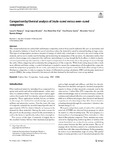Mostrar o rexistro simple do ítem
Comparison by thermal analysis of Joule‑cured versus oven‑cured composites
| dc.contributor.author | Vázquez, Laura | |
| dc.contributor.author | López-Beceiro, Jorge | |
| dc.contributor.author | Díaz-Díaz, Ana-María | |
| dc.contributor.author | Álvarez García, Ana | |
| dc.contributor.author | Pereira Rodríguez, Mercedes | |
| dc.contributor.author | Artiaga, Ramón | |
| dc.date.accessioned | 2024-05-24T09:29:13Z | |
| dc.date.available | 2024-05-24T09:29:13Z | |
| dc.date.issued | 2024-03-20 | |
| dc.identifier.citation | Vázquez, L.S., López-Beceiro, J., Díaz-Díaz, AM. et al. Comparison by thermal analysis of Joule-cured versus oven-cured composites. J Therm Anal Calorim (2024). https://doi.org/10.1007/s10973-024-13002-0 | es_ES |
| dc.identifier.issn | 1588-2926 | |
| dc.identifier.uri | http://hdl.handle.net/2183/36610 | |
| dc.description | Financiado para publicación en acceso aberto: Universidade da Coruña/CISUG | es_ES |
| dc.description.abstract | [Abstract]: The current technology for curing high-performance composites, such as those used in industries like such as aeronautics and the automotive industry, is based on the use of autoclaves, where the material is cured by external heating, in large ovens. This type of curing requires enormous amounts of energy, of which only a small part is invested in the actual curing of the material, and the rest is mainly used for heating and maintaining the temperature of the autoclave. An alternative method that entails a lower energy cost compared to the traditional methodology is curing through the Joule effect, in which an electric current is passed through the material, so that it acquires temperature from the inside due to the passage of current through the carbon fibres, triggering and accelerating the curing process of the composite. While Joule curing may provide a much more efficient and faster curing, a control technology is needed to ensure that temperatures all throughout the composite match the temperature programme. In this work, a procedure has been developed to control the Joule effect curing of carbon fibre/epoxy composites in order to compare, by means of differential scanning calorimetry (DSC) and dynamic mechanical analysis (DMA), the curing obtained by this method with that obtained by the traditional oven curing method. | es_ES |
| dc.description.sponsorship | We acknowledge the financial support provided by the Ministerio de Ciencia e Innovación (Spain), under grant PID2020-113578RB-100, and the Programa de Doutoramento Industrial 2022, funded by Xunta de Galicia, through the grant number 07_IN606D_2022_2695330. | es_ES |
| dc.description.sponsorship | Xunta de Galicia: 07_IN606D_2022_2695330 | es_ES |
| dc.language.iso | eng | es_ES |
| dc.publisher | Springer | es_ES |
| dc.relation | info:eu-repo/grantAgreement/AEI/Plan Estatal de Investigación Científica y Técnica y de Innovación 2017-2020/PID2020-113578RB-100/ES | es_ES |
| dc.relation.uri | https://doi.org/10.1007/s10973-024-13002-0 | es_ES |
| dc.rights | Attribution 4.0 International https://creativecommons.org/licenses/by/4.0/ | es_ES |
| dc.rights.uri | http://creativecommons.org/licenses/by/3.0/es/ | * |
| dc.subject | Carbon fibre | es_ES |
| dc.subject | Composites | es_ES |
| dc.subject | Joule curing | es_ES |
| dc.subject | DSC | es_ES |
| dc.subject | DMA | es_ES |
| dc.title | Comparison by thermal analysis of Joule‑cured versus oven‑cured composites | es_ES |
| dc.type | info:eu-repo/semantics/article | es_ES |
| dc.rights.access | info:eu-repo/semantics/openAccess | es_ES |
| UDC.journalTitle | Journal of Thermal Analysis and Calorimetry | es_ES |
| dc.identifier.doi | https://doi.org/10.1007/s10973-024-13002-0 |






